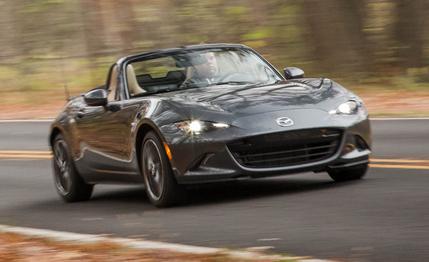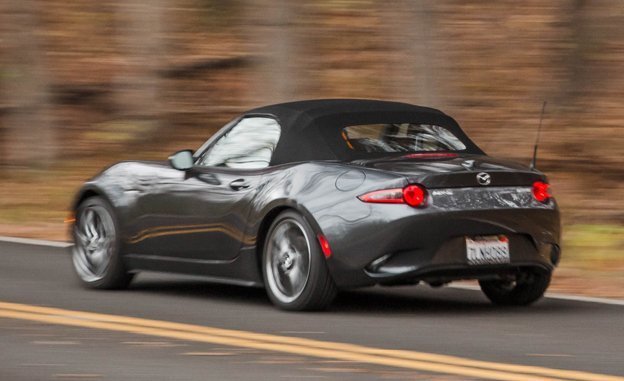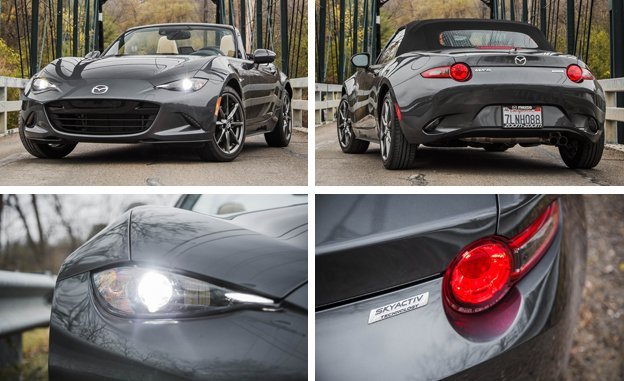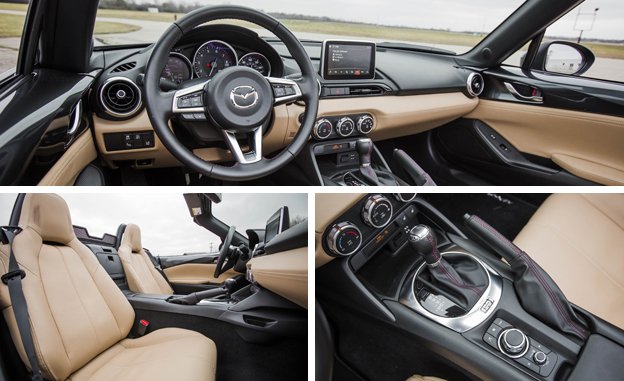 Instrumented Test
Instrumented Test
The 2016 Mazda MX-5 Miata stirs the road poets among us to romantic motoring visions: traffic-free dawns on challenging canyon two-lanes; adrenaline-soaked track-day afternoons; the after-dinner getaway with your one-and-only. That’s the stuff that put the fourth generation of Mazda’s little road star back on our 10Best Cars list. It inspires drivers to get out there, carpe every damned diem, and double-clutch down on the experience.
Mazda also sells MX-5s to people who feel the need for speed only when racing from the coffee shop to the conference room. Many of us live where most of the corners measure 90 degrees, the land is flat, and the traffic flows like peanut butter through a funnel. These drivers harbor the same fantasies of dancing on pavement as we all do—they like sharp steering, enjoy nimble handling, and want to feel at-one with their rides, but they also want to get to work without a stiff left leg.

Which is a longer way to say that some Miata buyers order an automatic transmission. A lot more of them today than was the case for the first-generation car in the 1990s, certainly, when the four-speed slushbox accounted for probably less than 10 percent of Miata sales. That thing was such a drag that putting one in a Miata seemed pointless. Hearing that someone had an automatic Miata made us think, “Go buy a Corolla and embrace your dull, gray inner drone, already.”
We didn’t even bother track-testing an automatic Miata until 2006. That was when a new six-speed and paddle-shifter combination arrived and we found it was, well, not so horribly bad. By 2011, Mazda was reporting that manual transmissions still dominated, but more than a third of softtop Miatas (37 percent) and more than half of the retractable-hardtop cars (59 percent) were sold without a clutch pedal.
This year’s new, lighter, tighter, and righter Miata makes a strong argument for the enjoyment and involvement of the stick shift, for getting all the way into the game with both feet and both hands. But clearly we couldn’t wait 16 years to get around to testing the automatic when about half the cars have it.

Suitably, our automatic-transmission test car arrived in the priciest, plushest of MX-5 trim levels, the Grand Touring. We tested the manual Miata in Club spec, which brings performance-enhancing hardware like a shock-tower brace, a limited-slip differential, and a sportier suspension tune. The Grand Touring skips those, instead including heated seats, leather upholstery, automatic climate control, rain-sensing wipers, and navigation. So far, fine. It also adds blind-spot monitoring, rear cross-traffic alert, lane-departure warning, and adaptive lights with automated high-beam control. Choosing a GT moves the base price up to $30,885 and the automatic adds another $1205. (The automatic upcharge on the base Sport model is $1480, while on the Club it’s only $730.)
Objectively speaking, the automatic also costs a bit of performance: half a second to 60 mph and about the same in the quarter-mile. And brake-torque launches don’t work because the Skyactiv 2.0-liter four-cylinder doesn’t really make enough torque to bust the tires loose. Blame the transmission, sure, but another factor is that this GT carried a little more weight, tipping our scales at 2383 pounds. The Club we tested came in at 2309. Seventy-four pounds may not seem like much, but it can have an outsized effect on a lightweight two-seater like this.
While Mazda deserves our applause for the discipline of keeping the new car small and light, it seems this particular version leans back, relaxes, and loosens the disciplinary belt. Despite the additional weight—and the lack of the sport-oriented chassis hardware that comes on the Club model—this car cornered at the same 0.90 g and stopped in the same 158 feet from 70 mph. It felt, perhaps, a little less eager in its responses than the Club.

In subjective terms, the automatic didn’t hurt as badly as we’d feared. In Sport mode, the latest paddle-shift mechanism works just as we’d like, delivering crisp gearchanges and holding the ratio the driver chooses right on to the rev-limiting fuel shutoff. In normal automatic driving with the gear selector in D, there’s nothing to object to except the lack of engagement.
We’ve previously noted that the 2016 model’s engine is louder and a bit coarser sounding than last year’s, and we noticed the interior mirror on this automatic example vibrating at idle. Still, we’re talking about a 21st-century interpretation of the old roadster ideal, not a direct revival of it. Whereas a ’96 manual-transmission Miata was spinning 4200 rpm at 80 mph, this new one is doing only 2200 rpm at the same speed, which is much more comfortable for cruising. This is not a soul-sucking joyless automatic; still, we’d like to see what Mazda could do with, say, a dual-clutch autobox in this car. As it is, the conventional automatic made stop-and-go traffic jams painless without seriously impeding the fun when we got a chance to avoid the crowds.
You’ll notice, though, that the Miata we just added to our long-term fleet has the manual transmission. Because we’re incurable romantics.